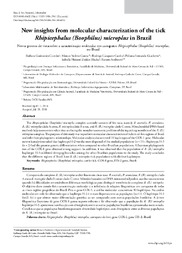New insights from molecular characterization of the tick Rhipicephalus (Boophilus) microplus in Brazil.
New insights from molecular characterization of the tick Rhipicephalus (Boophilus) microplus in Brazil.
Author(s): CSORDAS, B. G.; GARCIA, M. V.; CUNHA, R. C.; GIACHETTO, P. F.; BLECHA, I. M. Z.; ANDREOTTI, R.
Summary: The Rhipicephalus (Boophilus) microplus complex currently consists of five taxa, namely R. australis, R. annulatus, R. (B.) microplus clade A sensu, R. microplus clade B sensu, and R. (B.) microplus clade C sensu. Mitochondrial DNA-based methods help Taxonomists when they are facing the morpho-taxonomic problem of distinguishing members of the R. (B.) microplus complex. The purpose of this study was to perform molecular characterization of ticks in all five regions of Brazil and infer their phylogenetic relationships. Molecular analysis characterized 10 haplotypes of the COX-1 gene. Molecular network analysis revealed that haplotype H-2 was the most dispersed of the studied populations (n = 11). Haplotype H-3 (n = 2) had the greatest genetic differentiation when compared to other Brazilian populations. A Bayesian phylogenetic tree of the COX-1 gene obtained strong support. In addition, it was observed that the population of R. (B.) microplushaplotype H-3 exhibited diverging branches among the other Brazilian populations in the study. The study concludes that the different regions of Brazil have R. (B.) microplus tick populations with distinct haplotypes.
Publication year: 2016
Types of publication: Journal article
Unit: Embrapa Beef Cattle
Observation
Some of Embrapa's publications are published as ePub files. To read them, use or download one of the following free software options to your computer or mobile device. Android: Google Play Books; IOS: iBooks; Windows and Linux: Calibre.
Access other publications
Access the Agricultural Research Database (BDPA) to consult Embrapa's full library collection and records.
Visit Embrapa Bookstore to purchase books and other publications sold by Embrapa.

